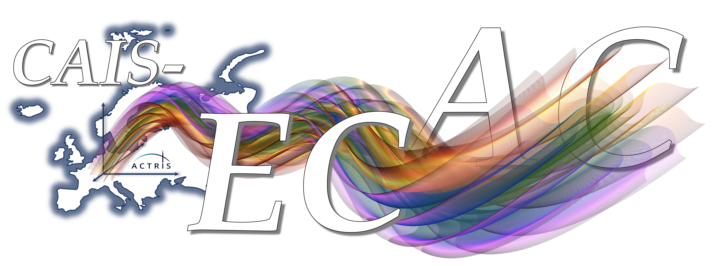
ACTRIS CAIS-ECAC Aerosol In-Situ Course:
Fundamentals & Methods for Aerosol Sampling and Physical & Chemical In-Situ Measurements
Date: April 16-22, 2023
Venue: National Atmospheric Observatory Kosetice, Czech Republic
Fundamentals & Methods for Aerosol Sampling and Physical & Chemical In-Situ Measurements
Date: April 16-22, 2023
Venue: National Atmospheric Observatory Kosetice, Czech Republic

EMC2: Opportunity to access EMC2 services through RADIATE Transnational Access (TA)
LABEC, the INFN accelerator laboratory hosting the EMC2 unit, is participating in a European research infrastructure of ion beam facilities, RADIATE (https://www.ionbeamcenters.eu/), that currently offers transnational access (TA) to the external-beam PIXE-PIGE facility for atmospheric aerosol sample analysis to external users.
Member of ACTRIS can benefit of this opportunity for high-sensitivity and high-throughput elemental analysis of atmospheric aerosols collected on daily, hourly and size-segregated (e.g. impactor) samples, using Ion Beam Analysis techniques, typically PIXE and PIGE with 3 MeV proton beams and exploiting a dedicated detection set-up made by an array of Silicon Drift Detectors for X-ray spectroscopy. Given the pandemic situation hands-off experiments are welcomed: the user sends the aerosol samples, we will analyse them and then we will send them back.
The users have to submit a proposal to RADIATE’s proposal submission system, RADIATE GATE (https:// gate.hzdr.de/user/). Check this presentation as a guideline.
Access is granted free of charge to positively evaluated proposals. Download the proposal template to prepare your proposal.
Information on how to submit a measurement proposal to RADIATE TA can be found at the following website:
https://www.ionbeamcenters.eu/radiate/radiate-transnational-access/
After the beam time at LABEC , once the measurements are finished, you will have to submit an experimental report in RADIATE GATE.
It is suggested that you contact Massimo Chiari (chiari@fi.infn.it) before submitting a proposal for advice on the beam analysis method and requested hours that are most appropriate, and for support in proposal submission.
LABEC, the INFN accelerator laboratory hosting the EMC2 unit, is participating in a European research infrastructure of ion beam facilities, RADIATE (https://www.ionbeamcenters.eu/), that currently offers transnational access (TA) to the external-beam PIXE-PIGE facility for atmospheric aerosol sample analysis to external users.
Member of ACTRIS can benefit of this opportunity for high-sensitivity and high-throughput elemental analysis of atmospheric aerosols collected on daily, hourly and size-segregated (e.g. impactor) samples, using Ion Beam Analysis techniques, typically PIXE and PIGE with 3 MeV proton beams and exploiting a dedicated detection set-up made by an array of Silicon Drift Detectors for X-ray spectroscopy. Given the pandemic situation hands-off experiments are welcomed: the user sends the aerosol samples, we will analyse them and then we will send them back.
The users have to submit a proposal to RADIATE’s proposal submission system, RADIATE GATE (https:// gate.hzdr.de/user/). Check this presentation as a guideline.
Access is granted free of charge to positively evaluated proposals. Download the proposal template to prepare your proposal.
Information on how to submit a measurement proposal to RADIATE TA can be found at the following website:
https://www.ionbeamcenters.eu/radiate/radiate-transnational-access/
After the beam time at LABEC , once the measurements are finished, you will have to submit an experimental report in RADIATE GATE.
It is suggested that you contact Massimo Chiari (chiari@fi.infn.it) before submitting a proposal for advice on the beam analysis method and requested hours that are most appropriate, and for support in proposal submission.

1st ACTRIS Science Conference - Call for abstract and registration are now open!
Dear ACTRIS Community,
It is with great pleasure that we invite you to register and submit your scientific contributions to the 1st ACTRIS Science Conference, due to take place virtually on May 11th-13th, 2022.
Important dates:
• Abstract submission deadline: 25 March 2022 – no late submission will be considered.
• Registration deadline: 2 May 2022
• Poster submission deadline: 4 May 2022
The conference will be held in conjunction with the ACTRIS course on atmospheric observations and will be organised jointly by the Institute for Atmospheric and Earth System Research (INAR) at the University of Helsinki, Atmosphere and Climate Competence Center (ACCC) at the University of Helsinki and the ACTRIS Interim Head Office.
More details can be found on the conference webpage: https://actris.eu/news-events/events/1st-actris-science-conference and in the attached announcement.
Best regards,
Giulia, on behalf of the ACTRIS Head Office
Dear ACTRIS Community,
It is with great pleasure that we invite you to register and submit your scientific contributions to the 1st ACTRIS Science Conference, due to take place virtually on May 11th-13th, 2022.
Important dates:
• Abstract submission deadline: 25 March 2022 – no late submission will be considered.
• Registration deadline: 2 May 2022
• Poster submission deadline: 4 May 2022
The conference will be held in conjunction with the ACTRIS course on atmospheric observations and will be organised jointly by the Institute for Atmospheric and Earth System Research (INAR) at the University of Helsinki, Atmosphere and Climate Competence Center (ACCC) at the University of Helsinki and the ACTRIS Interim Head Office.
More details can be found on the conference webpage: https://actris.eu/news-events/events/1st-actris-science-conference and in the attached announcement.
Best regards,
Giulia, on behalf of the ACTRIS Head Office

New Information:
The ECAC, are happy to announce the release of the ACTRIS whitelist for aerosol in‐situ instrumentation at observatories.
The ECAC, are happy to announce the release of the ACTRIS whitelist for aerosol in‐situ instrumentation at observatories.










